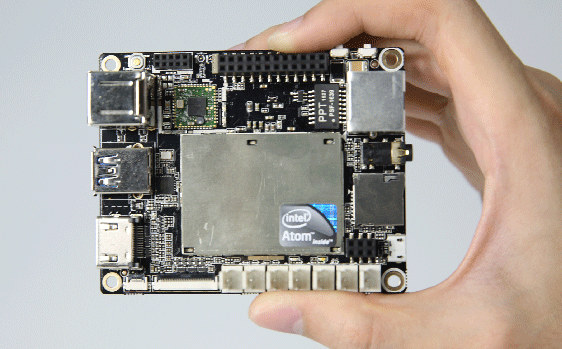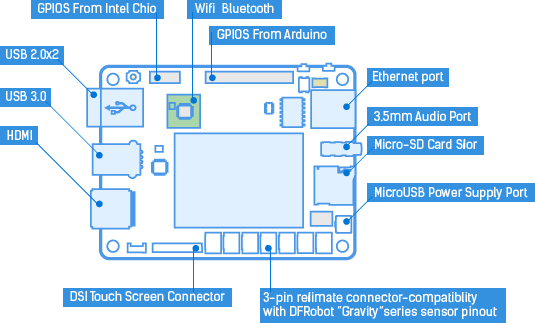I feel like I’m living in another world after writing a title combining Arduino, Intel and Windows 10, but that’s exactly what LattePanda is promising with a development board featuring both an Intel Atom x5-Z8300 processor and an Atmel AVR MCU, and Windows 10 as the operating system.
 LattePanda board specifications:
LattePanda board specifications:
- SoC – Intel Atom x5-Z8300 “Cherry Trail” quad core processor @ 1.44 GHz (Burst frequency: 1.84 GHz) with Intel Gen8 HD graphics @ 500 MHz
- System Memory – 2 to 4 GB DDR3L
- Storage – 32 or 64 GB eMMC, micro SD slot
- MCU – Atmel Atmega32u4 micro-controller
- Video Output / Display – HDMI, and MIPID DSI connector
- Audio I/O – HDMI, 3.5mm audio port
- Connectivity – Ethernet, WiFi and Bluetooth 4.0
- USB – 1x USB 3.0 port, 2x USB 2.0 host ports, 1x micro USB port for power
- Serial – 1x from Intel SoC, 1x from Atmel MCU
- Expansion
- Intel processor header with 2 GPIOs
- Atmel MCU “Arduino” header with 20 GPIOs
- 7x 3-pin relimate connectors compatible with DFRobot “Gravity” sensors.
- Misc – Wake-on-LAN support
- Power Supply – 5V via micro USB port
- Dimensions – 88 x 70 mm
The company also mentions the board is Android and Linux compatible, but it’s not clear if they plan to do much work on these two operating systems.

The claim that ” Lattepanda comes pre-installed with a full edition of Windows 10, including powerful tools such as Visual Studio, NodeJS, Java, Processing, and more!” probably means it’s only a trial version based on their aggressive pricing, and lack of details about the exact version. I assume you’ll be able to program the Arduino part, just like as if you had an Arduino board connected to a Windows 10 PC. Tutorials and documentation should eventually be posted on Lattepanda.com, but right now there are only a few pictures.
The company plan to launch a Kickstarter campaign in order to raise at least $150,000 for mass production. A 45 GBP ($67) early bird pledge would get you a LattePanda board with 2GB RAM, 32GB eMMC, and Windows 10, with the pricing going up to 53 GBP (~$79) after the first 100 units are taken. A higher version with 4GB RAM and 64GB eMMC, called LattePanda Enhanced, is also offered for $129, and starter kits with a 7″ display will also be available. Shipping is 13 GBP (~$20), and delivery is scheduled for March 2016.
Via Liliputing

Jean-Luc started CNX Software in 2010 as a part-time endeavor, before quitting his job as a software engineering manager, and starting to write daily news, and reviews full time later in 2011.
Support CNX Software! Donate via cryptocurrencies, become a Patron on Patreon, or purchase goods on Amazon or Aliexpress





It seems to me that the Win10 Bing edition aggressive price for constructors is limited to 2GB ram / 32 GB rom hardware.
Am i right ?
If so, then you’re probably right about the trial version.
Or even worse : it could be a full version for the 1st model and a trial one for the enhanced board…
Lol, I don’t even know why you need x86 on this much less Windows 10 … so a trial will do just fine. You can wipe it and install Linux 😀
@Marius Cirsta
Or not, as there’s no official Linux support from Intel for these processors, yet, if ever.
WoL = NAS!
@TC
Uhm, it has no SATA interface… Technically I guess you could plug it in to a USB 3.0 drive enclosure, but why?
The SoC has no SATA implementation but a single PCIe 2.0 lane. Therefore you would need a separate PCIe controller on the board (maybe already used for Ethernet, but that might be USB-Ethernet instead).
Next problem: People expect SATA power also when a SATA port is present.
And also good look when using all 3 USB ports (2 x 500mA + 1 x 900mA): The current allowed to be drawn just by USB consumers already exceeds what the DC-IN connector is able to provide (micro USB is rated 1.8A max.)
@tkaiser
It’s most likely used for the Ethernet in this instance, as there’s a USB 3.0 port and the processor doesn’t have a GMAC. I’ve seen a different implementation where the USB 3.0 is used for Ethernet, mainly to allow for a simpler board design/fewer PCB layers compared to using PCI Express.
It’s easy to do more power over micro USB, plenty of small form factor computers d0 2.5/3/3.5A over micro USB, the problem is that the price of the power adapter goes up exponentially as you go up in power, as it’s hard to do high Amperage compact 5V power adapters.
I’m curious though if the board designers actually weigh this in, since most devices wouldn’t be drawing peak power from the ports… which causes problems with some hard drives etc. that draws peak power.
That’s interesting. Can you point me please to a few? According to the specs http://mgvs.org/public/shema/datasheet/usb_20/Micro-USB_final/ this is a clear violation by factor 2 and we experience problems with this connector so many times… mostly not due to the connector but ‘the average USB cable’ being crap leading to voltage drops which then result in the user buying a higher rated PSU.
The price is not bad at all.
For the rest: depends a bit if they will listen to what people complain about…
power consumption will beat any currently avaiable SoHo NAS
I can’t wait for their campaign on Kickstarter. So , Pressing “Notify me on launch” is all I can do right now.
And it’s live https://www.kickstarter.com/projects/139108638/lattepanda-a-45-win10-computer-for-everything/
What about this? https://www.kickstarter.com/projects/139108638/lattepanda-a-45-win10-computer-for-everything?ref=users.
It’s like there are 2 projects on the go. Are the same?
@Manolo
Look like the same one to me. The previous link was a preview, but they’ve posted in the comments there that the project has gone live.
@TC
You pay that much for electricity? Besides, the part that draws a lot of power is the hard drives, not the CPU, in a NAS.
Interesting with regards to the 2/4GB RAM discussion http://liliputing.com/2015/11/intels-cheapest-atom-x5-chip-supports-4gb-of-ram-after-all.html
Immediately I went the starter site and watch the video .
COOL !!
But why will they not show its back side on earth ?
@Hiro
They did not have the video yesterday. They did a good job here 🙂
0,30€/KWh… Germany \o/
2,5″ HDD do 0,5W when idle, but the lowest idle draw of a NAS i found was 4W – without any drives
i dont understand why, because nowaday mobile/ tablet ARM SoC’s draw <1W for the whole system
Use any A20 based board with GBit Ethernet and a 2.5″ HDD connected to the SATA port and you’ve the ability to get a NAS that idles at 1.5W (disk spin-down through hdparm): http://linux-sunxi.org/Sunxi_devices_as_NAS
A kickstarter campaign, Intel? Seriously ? They made billions last quarter. This is just a cheap trick. And when its about to fail, Intel can shell out their own money and show off that the campaign is a success to create a mirage.
And without official Linux support, I would not buy it. I don’t want to waste my money on windows
@Jay Aurabind
I don’t think that’s a board made buy Intel, or that Intel is directly involved in the project. It’s just a startup that happens to make a board with an Intel processor.
@cnxsoft
Guess I overlooked that part. But linux support is absolutely necessary.
@Marius Cirsta
Do you have knowledge about this.If you have than welcome in discuss with me
Regards Sagheer ahmed CEO IRAD Solution
sagheerghanjera41@gmail.com
Hi,
I just have a question: is it possible to use as an Arduino??
I mean, can I upload sketches on it?
Thanks in advance for any answer
This Intel Atom X-5 Z8300 CPU with Cherry Trial 12 EU or 96 Core GPU is a pretty Powerful Combo would like to get the 4 GB Ram and 64 GB Emmc which is not bad for the Price when including a 7 inch Screen and Windows 10! Also yes you can install Linux also Android 5.1.1 _ Enjoy
@HTMLator
Answer is Yes you can use as a Ardruino also as a Full Fuction PC or even may a Smart TV some have even used in Drones as you see in the Video! if you have any more quistions please feel free to ask me – Fred
Will they release design files ( pcb board design and schematic ) like MinnowBoard did?
I’m very very happy for the device.
But, one thing is that there is n tutorials how to use it.
So I’m cordially requesting you to upload some tutorials about how to use it in case of high range drone and robotics.
LattePanda with 2GB RAM, 32GB storage and Windows 10 license for $140 on DX -> http://www.dx.com/p/lattepanda-2g-32gb-windows10-pc-development-board-w-win10-product-key-447892?Utm_rid=93072394&Utm_source=affiliate
It’s much cheaper on DFRobots though: https://www.dfrobot.com/index.php?route=product/category&path=175_177
donde puedo comprarlo